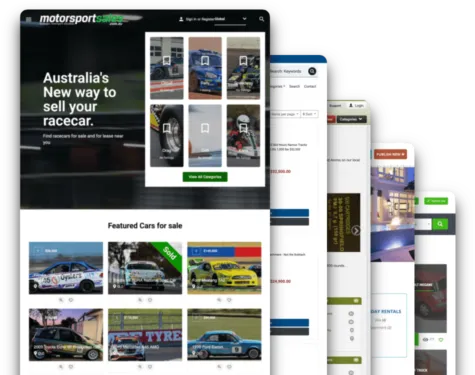In today’s digital landscape, online marketplaces have become the backbone of e-commerce and service exchanges. These platforms bridge the gap between buyers and sellers, facilitating transactions across various industries.

However, not all online marketplaces are created equal.
Successful marketplaces share key features that enable user engagement, seamless transactions, and sustained growth.
Today, we'll explore the essential features every online marketplace should have, provide some real-life examples, highlights challenges and solutions, and predict some innovations in the industry.
1. Intuitive and User-Friendly Interface
A well-designed interface is the cornerstone of any online marketplace.
Users should find it easy to navigate, search, and interact with the platform.
Key Elements of a User-Friendly Interface:
- Clear Navigation: Simple menus and filters that guide users to what they need.
- Mobile Responsiveness: A seamless experience across devices, especially since mobile accounts for over 60% of online transactions.
- Minimal Onboarding Steps: Quick sign-ups with social login options to reduce friction.
Case Study: Airbnb revolutionized online booking with its clean design and intuitive search filters. Users can easily find listings based on location, price, and amenities.
Challenge:
Designing an interface that caters to diverse user demographics.
Solution:
Conduct user testing to refine the experience and prioritize accessibility features like text-to-speech and high-contrast modes.

2. Robust Search and Filtering Options
Efficient search functionality ensures that users can quickly find products or services that meet their needs.
Features to Include:
- Keyword Search: Supports natural language processing (NLP) to understand user intent.
- Advanced Filters: Options like price range, categories, ratings, and location.
- Autocomplete Suggestions: Predictive text to guide users during search.
Data Insight: Studies show that marketplaces with optimized search tools see a 20-30% increase in user engagement.
Example: Amazon sets the standard with its precise filters, including customer reviews, price ranges, and product categories.

3. Secure Payment Gateway
A secure and versatile payment system builds trust among users. It is critical to offer multiple payment methods while ensuring transaction safety.
Key Features:
- SSL Encryption: Protects user data during transactions.
- Multiple Payment Options: Credit cards, digital wallets, and even cryptocurrencies.
- Escrow Services: Hold payments until the buyer confirms satisfaction.
Case Study: Etsy uses integrated payment solutions to manage global transactions while prioritizing seller payouts and user security.
Challenge:
Preventing fraudulent transactions and data breaches.
Solution:
Invest in AI-driven fraud detection systems and regular compliance audits.
4. Rating and Review System
Transparency fosters trust in online marketplaces. A robust rating and review system allows users to make informed decisions.
Components of an Effective System:
- Star Ratings: Quick visual cues about product/service quality.
- Detailed Reviews: Written feedback to provide context.
- Verified Purchases: Ensures authenticity of reviews.
Real-Life Success: Uber thrives on its dual rating system, where both riders and drivers rate each other, ensuring accountability on both ends.
Statistic: Marketplaces with verified reviews report 18% higher conversion rates.
5. Comprehensive User Profiles
User profiles provide a sense of identity and trust within the marketplace. Both buyers and sellers benefit from detailed, credible profiles.
Must-Have Features:
- Profile Verification: Through email, phone, or government IDs.
- Portfolio/Listing Showcase: Allows sellers to display their expertise or inventory.
- User Activity Metrics: Number of completed transactions, reviews, and ratings.
Example: Fiverr enhances user trust by showcasing seller ratings, response times, and completed projects.
Challenge:
Balancing privacy with transparency.
Solution:
Provide users with control over what information is publicly displayed.
6. Seamless Communication Tools
Effective communication between users is vital for building trust and closing transactions.
Communication Features:
- In-App Messaging: Real-time chat with notifications.
- Transaction History: Stores all correspondence related to specific transactions.
- Language Translation: For global marketplaces, AI-driven translation tools are invaluable.
Case Study: eBay uses an integrated messaging system that keeps buyers and sellers connected while flagging inappropriate content.
7. Scalability and Integration Capabilities
As marketplaces grow, they must scale without compromising performance. Integration with third-party tools can also enhance functionality.
Scalability Requirements:
- Cloud-Based Infrastructure: Ensures uptime and handles traffic spikes.
- API Support: Allows integration with tools like shipping services and CRM software.
Example: Shopify’s marketplace model includes integration with apps like Mailchimp for marketing and ShipStation for logistics.
Challenge:
Managing exponential growth while maintaining platform speed.
Solution:
Adopt microservices architecture and conduct regular performance tests.
8. Personalized User Experience
Personalization drives user engagement and loyalty.
Tools for Personalization:
- AI Recommendations: Suggest products or services based on user behavior.
- Tailored Notifications: Alerts for price drops, new listings, or messages.
- Saved Preferences: Users can bookmark searches or favorite items.
Real-Life Example: Netflix uses machine learning algorithms to deliver personalized content suggestions, increasing user retention rates.
Next Steps!
Want more information on how to create the key features in a marketplace? Contact us at Yclas!
We're happy to assist in launching your next marketplace idea.

